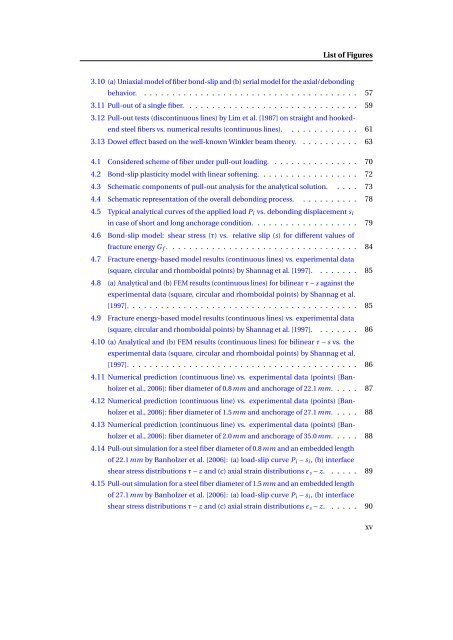tesi A. Caggiano.pdf - EleA@UniSA - Università degli Studi di Salerno
tesi A. Caggiano.pdf - EleA@UniSA - Università degli Studi di Salerno
tesi A. Caggiano.pdf - EleA@UniSA - Università degli Studi di Salerno
- No tags were found...
Create successful ePaper yourself
Turn your PDF publications into a flip-book with our unique Google optimized e-Paper software.
List of Figures3.10 (a) Uniaxial model of fiber bond-slip and (b) serial model for the axial/debon<strong>di</strong>ngbehavior. . . . . . . . . . . . . . . . . . . . . . . . . . . . . . . . . . . . . . . 573.11 Pull-out of a single fiber. . . . . . . . . . . . . . . . . . . . . . . . . . . . . . . 593.12 Pull-out tests (<strong>di</strong>scontinuous lines) by Lim et al. [1987] on straight and hookedendsteel fibers vs. numerical results (continuous lines). . . . . . . . . . . . . 613.13 Dowel effect based on the well-known Winkler beam theory. . . . . . . . . . . 634.1 Considered scheme of fiber under pull-out loa<strong>di</strong>ng. . . . . . . . . . . . . . . . 704.2 Bond-slip plasticity model with linear softening. . . . . . . . . . . . . . . . . . 724.3 Schematic components of pull-out analysis for the analytical solution. . . . . 734.4 Schematic representation of the overall debon<strong>di</strong>ng process. . . . . . . . . . . 784.5 Typical analytical curves of the applied load P i vs. debon<strong>di</strong>ng <strong>di</strong>splacement s iin case of short and long anchorage con<strong>di</strong>tion. . . . . . . . . . . . . . . . . . . 794.6 Bond-slip model: shear stress (τ) vs. relative slip (s) for <strong>di</strong>fferent values offracture energy G f . . . . . . . . . . . . . . . . . . . . . . . . . . . . . . . . . . 844.7 Fracture energy-based model results (continuous lines) vs. experimental data(square, circular and rhomboidal points) by Shannag et al. [1997]. . . . . . . . 854.8 (a) Analytical and (b) FEM results (continuous lines) for bilinear τ− s against theexperimental data (square, circular and rhomboidal points) by Shannag et al.[1997]. . . . . . . . . . . . . . . . . . . . . . . . . . . . . . . . . . . . . . . . . 854.9 Fracture energy-based model results (continuous lines) vs. experimental data(square, circular and rhomboidal points) by Shannag et al. [1997]. . . . . . . . 864.10 (a) Analytical and (b) FEM results (continuous lines) for bilinear τ − s vs. theexperimental data (square, circular and rhomboidal points) by Shannag et al.[1997]. . . . . . . . . . . . . . . . . . . . . . . . . . . . . . . . . . . . . . . . . 864.11 Numerical pre<strong>di</strong>ction (continuous line) vs. experimental data (points) [Banholzeret al., 2006]: fiber <strong>di</strong>ameter of 0.8mm and anchorage of 22.1mm. . . . . 874.12 Numerical pre<strong>di</strong>ction (continuous line) vs. experimental data (points) [Banholzeret al., 2006]: fiber <strong>di</strong>ameter of 1.5mm and anchorage of 27.1mm. . . . . 884.13 Numerical pre<strong>di</strong>ction (continuous line) vs. experimental data (points) [Banholzeret al., 2006]: fiber <strong>di</strong>ameter of 2.0mm and anchorage of 35.0mm. . . . . 884.14 Pull-out simulation for a steel fiber <strong>di</strong>ameter of 0.8mm and an embedded lengthof 22.1mm by Banholzer et al. [2006]: (a) load-slip curve P i − s i , (b) interfaceshear stress <strong>di</strong>stributions τ − z and (c) axial strain <strong>di</strong>stributions ε s − z. . . . . . 894.15 Pull-out simulation for a steel fiber <strong>di</strong>ameter of 1.5mm and an embedded lengthof 27.1mm by Banholzer et al. [2006]: (a) load-slip curve P i − s i , (b) interfaceshear stress <strong>di</strong>stributions τ − z and (c) axial strain <strong>di</strong>stributions ε s − z. . . . . . 90xv
















